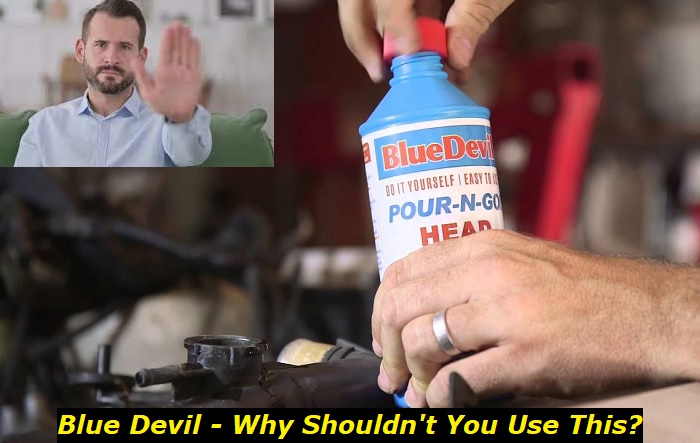Nobody wants to end up in the middle of the road with a misbehaving engine and smoking tailpipes. When your engine sputters with the tailpipe emitting white smoke, everything could follow- the electricity, timing, and ignition. The thought alone could bring anyone into a series of panic: from the extent of damage to your cylinder heads to the costly repairs.
Additives for leaks highlights
- Efficiency:close to zero
- Availability:agood deal of brands
- Average price: $35
- Way to use:pour into the coolant tank
- DIY use:yes
- Experts' advice:only biased advice
- Independent testing:onlynegative
- Consequences:contaminated coolant, contaminated cooling system, no effect whatsoever

What is Blue Devil Head Gasket Sealer?
Blue Devil is a solution for sealing cracks, leaks, blown head gaskets, and warped heads. You can also use it for leaking radiators, heater cores, and freeze plugs. This agent is compatible with four or six-cylinder engines.
Your head gasket is supposed to keep engine coolant and oil from entering the engine. Additionally, the head gasket should seal combustion gasses.
The product has been around since 1997 and still sees itself as a permanent sealing solution for oil leaks targeting the engine.
How does Blue Devil Head Gasket Sealer Work?
The Blue Devil's main active ingredient is sodium silicate. You can find sodium silicate in adhesives, inorganic polymers, and detergents. It is an agent that could take the engine heat after it cures.
When poured into the coolant reservoir, the sodium silicate flows and tries to find leaks and cracks in the head gaskets. Once it finds one, it will settle into the cracks or leak slowly as the engine heats up. The sodium silicate will react to heat and oxygen and form a strong chemical bond, a hardened form of strong and durable sealant. This bond makes a semi-permanent patch to the crack or leak, preventing oil and coolant from seeping into the engine.
Does Blue Devil Sealer Work?
Blue Devil sealant works. Most of the reports and feedback we received say the product momentarily prevents leaks. With the correct method of application, it should work.
However, Blue Devil, just like any sealant, is still a band-aid solution and could produce long-term effects on the engine, coolants system, radiator, and water pump.
It works depending on the extent of the damage. We would advise it to use on minor leaks. But for any major leaks, our recommendation is to replace affected components.
How Long Does Blue Devil Last?
There's no guarantee that Blue Devil will last for years. Some owners got lucky for having them last over one year.
The longevity of this product depends on many factors. It depends on the extent of damage, your application process, and the material of the radiator or tubes. But on average, Blue Devil could last between 5,000 to 10,000 miles for minor leaks, which is about 6 to 12 months, depending on the driving habits. Some had them working for only a few weeks. While you can use it again when the leaking reappears, it doesn't guarantee a permanent fix or repair.
Why Shouldn't You Use Blue Devil?
1) It's a temporary fix
Any gasket sealant does not address the real issue but only delays repair. It could prolong the life of your head gasket but does not solve the problem.
When repairing a blown head gasket, remove it with the cylinder heads. You must clean their mating surfaces thoroughly before replacing them with new gaskets and cylinder heads.
Next, you have to flush the coolant thoroughly. Most manufacturers would not allow the cylinder head to get skimmed. It is necessary to ensure that the mating surface is flat. But in most cases, undergoing this process is not worth it. It's wiser to replace it with a new or renewed engine.
2) It may ruin the cooling system
It clogs coolant passages. This event is something that Blue Devil or other head gasket sealers will not tell you.
The substance will look for holes or cracks, including the coolant passages, to settle. It will sit there and cure when it finds that spot in your coolant passages. The problem with head gasket sealers is they are hard to remove. And trying to scrape them off your engine is not advisable.
Although Blue Devil advertises that the product does not include particulate matter, it will seep through the tubes and coolant passages. It works to seal leaks. But sooner or later, you'd have to visit your technician to replace your coolant, radiator, or thermostat.
Also, it is not advisable for systems that have severe damage.
One thing to remember if you still push through with this product is to remove your thermostat before pouring Blue Devil.
3) It may affect thermostat performance
Blue Devil advises removing the thermostat before pouring the product. Because the product uses sodium silicate, the product will form a transparent glass-like seal on the surfaces. Adding more sealant when the thermostat is already sealed will interfere with its performance. The thermostat will have trouble opening and closing at the proper temperature. The thermostat will fail to keep the engine cool or stop cooling when the engine is.
4) It may cause blockages in the radiator
In many cases where Blue Devil has plugged up the radiator, we can assume that they have performed the instructions wrongly. Even so, you still have no idea how long the blue liquid-turned-sealant lasts. Like the coolant passages, you have no idea where inside the radiator it can go. It could go into the heater core.
Also, remember that glass sealant will not expand with the gaps made by leaks and will crack into small pieces. It would just produce white chunks that would restrict the flow of heat transfer.
If it ends up like that, you have nothing else to do but face the real problem. Repair the gaskets and replace the old radiator with a new radiator because flushing it is useless.
5) It is not compatible with all engines
It can fit into different engines. Be it a 4 or 6-cylinder, diesel, or gasoline, Blue Devil should work. You can use the Blue Devil on cast-iron engine blocks.
However, some studies revealed the negative effects of sodium silicate on the protective anti-corrosion layer in aluminum. Although the company claims it to be compatible with all types of engines, you might want to have second thoughts if your engine block is aluminum.
Before using it for your coolant or radiator, know the materials they are made of and find out how they react to the sodium silicate.
6) It's hard to remove
Once you realize that Blue Devil or other head gasket sealants have messed up on your coolant system, radiator, or engine, you will try everything to flush it out. However, when you try to scrape off the hardened sodium silicate, it will produce scratches. Along with the heat, you introduce future cracks to your engine slowly.
When you are in a situation where you need to remove the gunk, expect that you will have to replace your radiator, thermostat, and water pump.
See, this blue liquid is very thick, hard, and tenacious. The substance can take enormous pressure and heat and still be intact.
7) It could void the warranty
Most carmakers discourage using any additives or chemicals they do not recommend for their engines. And if you just purchased your car, adding a Blue Devil may void your warranty. For sensitive repairs, such as blown gaskets, talk to your mechanic before pouring sealants into your radiator. Or the least you can do is see your manual.
Is Using Blue Devil Recommended?
We only recommend Blue Devil for minor leaks. And since you come across this section, you probably know how it can affect your engine. The best fix we could recommend is replacing the affected components. Replacing the head gaskets could cost as much as $3,000.
Should You Use Blue Devil Oil Twice?
You can use it again, but doing so would only add to the present blockages if you do not use the product according to instructions.
How Do You Avoid Using Blue Devil Sealant?
Most head gasket failures are the result of overheating. Other reasons for head gasket failure are warped cylinder heads, aging, or improper installation. The best way to prevent using head gasket sealants is to address engine or cooling system issues as soon as they arise.
- Always check your coolant and engine oil levels.
- Monitor your car engine's temperature.
- Top up your coolant reservoir with recommended coolant.
- Replace radiator hoses and thermostat as needed.
- Get a professional inspector if you will purchase a second-hand vehicle.
Final Thoughts
To summarize, Blue Devil is not for car owners looking for a permanent fix and considering a reliable and long-lasting head gasket repair. Blue Devil is designed to help those people who want to hold their blown head gaskets a bit longer until they can address the problem.
To answer our first question, we cannot guarantee that Blue Devil will last over a year. From the reports we received, the longest time that Blue Devil still seals in good condition is about six to twelve months. It could hold those leaks enough for you to save up and seek a more reliable bleak repair. But remember, the seal would be challenging to remove.
So, think twice before pouring Blue Devil into your engine.
About the authors
The CarAraC research team is composed of seasoned auto mechanics and automotive industry professionals, including individuals with advanced degrees and certifications in their field. Our team members boast prestigious credentials, reflecting their extensive knowledge and skills. These qualifications include: IMI: Institute of the Motor Industry, ASE-Certified Master Automobile Technicians; Coventry University, Graduate of MA in Automotive Journalism; Politecnico di Torino, Italy, MS Automotive Engineering; Ss. Cyril and Methodius University in Skopje, Mechanical University in Skopje; TOC Automotive College; DHA Suffa University, Department of Mechanical Engineering






Add comment